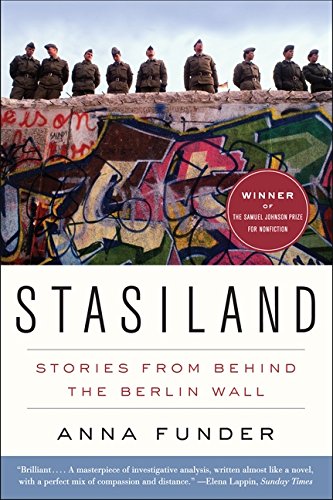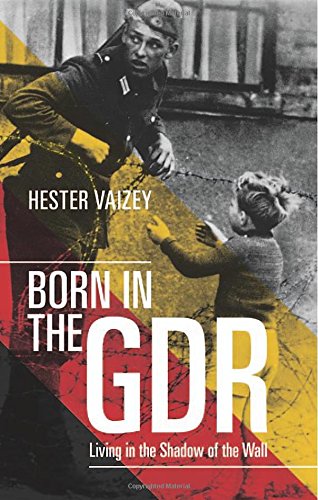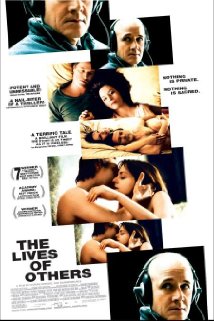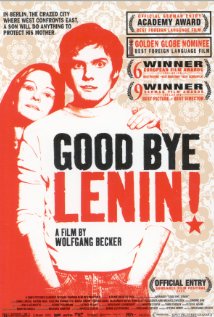While it’s true that the 12 years of the Third Reich still play a large role in German cultural memory and identity, more recent historical events loom much larger in the collective conscious of today’s Germany: the years between 1945 and 1990, when the country was split into East Germany (the German Democratic Republic- GDR in English / DDR auf Deutsch) and West Germany (the Federal Republic of Germany- FRG = English / BRD auf Deutsch). As a tourist, a long-term visitor or a resident in Germany, you’ll see that the division between East and West Germany still affects the country today, in areas including the economy, political attitudes, racism and more. You’ll also see the physical effects of this division, especially in Berlin, which was divided into two cities (one controlled by the FRG and one controlled by the GDR), from 1961 until 1989.
Sound overwhelming? There’s half a century of backstory to learn here, but it’s definitely doable. By learning these 10 vocab words related to the country’s division and eventual reunion, you’ll be well on your way to understanding this crucial time period for Deutschland.
Why Learn about German History from 1945 to the Present?
1. Most Germans alive today lived through this time.Many people who were adults during the Third Reich and World War II have now died of old age. But everyone you meet over the age of 25 in Germany was alive during the country’s division. Understanding the history of the divided country will go a long way towards helping you understand the German people’s psychology, prejudices and attitudes.
2. The division of Germany still has a huge effect on the country today.
Last fall, Germany made international headlines when PEGIDA, a Dresden-based far-right, anti-Islam organization, marched in cities around the country. Germans who disagreed with PEGIDA grumbled that of course a far-right, anti-Islam movement would come out of Dresden. After all, the city was located in one of two Tal der Ahnungslosen, or Valley of the Clueless [Tal = valley; Ahnung = clue], during the Cold War. Dresden’s section of southeast Germany and another part of northeast Germany could not receive television broadcasts from the west—hence the stereotype that these regions are ill-informed to this day.
This Dresdener stereotype is just one way that Germany’s division still has bearing on the country today. You’ll find evidence of this division in large-scale matters such as the economic discrepancy between east and west, and small-scale matters such as brand loyalty to Nutella versus brand loyalty to Nudossi, the East German version of Nutella.
3. As a tourist, you’ll see remnants of this division
If you visit Berlin, you’ll see pieces of the Berlin Wall still standing and covered with graffiti, Trabants (cars) zooming through the streets, murals depicting scenes from 1961 and 1989, Stolpersteine (stumbling stones) embedded into the cobblestone to commemorate those who "disappeared," and even different traffic signals (Ampelmännchen) in East Berlin and West Berlin. Understanding what all of this means will greatly enhance your experience as a tourist in Berlin and Germany.
Where Can You Learn More About This Time Period?
I can't resist adding these cultural gems:
1. “Stasiland” by Anna Funder (published in 2003)This book is about the East Germans who resisted the GDR, the people who worked for the Stasi (the GDR’s secret police) and how those two groups coexist in German society now. Funder’s book largely condemns the GDR and its system for its surveillance state, its murders and its torture, a viewpoint shared by many Germans today. Read more about “Stasiland” in The Guardian.
2. “Born in the GDR: Living in the Shadow of the Wall” by Hester Vaizey
(Oxford University Press in January 2015)
The book tells a slightly different story than “Stasiland.” Vaizey interviewed 8 former East Germans about their experiences during Germany’s division and reunification. In the process of doing so, she met people spanning the gamut of opinions about the GDR, including people who had been imprisoned by the Stasi, people who felt resentful that West Germany had absorbed East Germany with no regard for the latter’s traditions, along with commentary on how their lives had changed after the fall of the wall. Vaizey’s book will give you a glimpse into the range of East German experiences.
3. The movie “The Lives of Others” (Das Leben der Anderen: 2006 German film and Best Foreign Language Film Academy Award winner)
The movie tells the story of Stasi agents spying on a playwright in the 1980s, and the ruinous fall-out that comes from intense state scrutiny of private lives.
4. The movie “Goodbye Lenin” ( much lighter award-winning film from 2003)
This film takes a much lighter approach to the GDR than “The Lives of Others.” Here, a devoted socialist woman falls into a coma before the Berlin Wall falls and wakes up after. Her son, fearing for her health, goes to great lengths to sustain the illusion that the GDR still exists and the wall is still standing.
Now finally: Yes, it was a complicated time in German history, and many people have complicated memories of it. But learn these ten words and you’ll be well on your way to a basic understanding of this period in German history.
10 German Words to Help You Understand Modern German History
1. Die Wende
Definition: the change, the turning pointHistorical significance: Die Wende is the name for the significant changes that rocked the GDR after the Berlin Wall fell in 1989, leading up to reunification in late 1990. Suddenly, East Germans could travel to the west. The GDR moved towards a market economy, held a free election and eventually reunited with West Germany on Oct. 3, 1990.
Read more about die Wende here.
2. Die Grenze
Definition: the border, the boundaryHistorical significance: Die Grenze signifies the border (called the Inner German Border) that ran between the GDR and the Federal Republic of Germany from 1949 to 1990, a 863-mile boundary extending from the Baltic Sea to Czechoslovakia. The heavily-guarded boundary, built to prevent GDR citizens from escaping into West Germany, separated two countries and two ways of life.
3. Der Ampelmann
Definition: related to die Ampel, which means traffic lightHistorical significance: If you visit Berlin, you’ll see ordinary walking signals in some parts of the city and distinctive walking men in little hats in other parts. These are the Ampelmann, the GDR-designed walking signal premiered in 1961. When Germany reunified, engineers started replacing the Ampelmann with western traffic signals. But Ampelmann enthusiasts who wanted to preserve some relics of GDR life protested, and now the Ampelmann lives on, on certain streets in Berlin and throughout Germany.
Learn more about the Ampelmann here.
4. Der Trabant
Definition: satelliteHistorical significance: The Trabant was the iconic car of East Germany (see photo top) , a small two-stroke engine vehicle produced by a Saxon auto-maker that many families saved up for decades to reserve and buy. Once purchased, it was typical to disassemble it before using it, to become self-sufficient, should any parts need replacing. Waiting for repair service could take additional years. After the wall fell, families streamed out of East Germany in their Trabants. You can spot these distinctive little cars around Berlin today—some of them are still in use (rent one by the hour, for fun), while others are used for decoration at cafes and tourist sites. Check out the Trabant museum in Berlin.
5. Ostalgie
Definition: a combination of the German word for East (Ost) and the word Nostalgie, which means nostalgia.Historical significance: The concept of Ostalgie is used to describe nostalgia for East Germany, something experienced by many residents of the eastern half of the country after reunification. Ostalgie can be used to describe nostalgia for the East German aesthetic (Trabants and the Ampelmann, for example) as well as a deeper nostalgia for a time before the upheaval of reunification. In 1989, the unemployment rate in East Germany was 0 percent; in 1992 the figure clocked in at 15 percent. In 2013 the figure stood at 9.5 percent, versus 5.8 percent in West Germany. It’s easy to see why some East Germans miss the positive aspects of their former country.
6. Ossi
Definition: a nickname, often derogatory, for Germans from the former east (derived again from the word Ost - East)Historical significance: 26 years after the fall of the Berlin Wall, the stereotype (das Vorurteil) that accompanies Ossis is that they are whining and ungrateful for the help given them by West Germany (which paid plenty of money for reunification, forfeiting upgrades to their own infrastructure, for instance in schools) as well as racist and uneducated, as evidenced by the PEGIDA demonstrations in fall 2014. They have accepted far fewer Syrian refugees, for instance, yet are the loudest in making claims against them.
7. Wessi
Definition: a nickname, often derogatory, for Germans from the former westHistorical significance: Just as Westerners have Vorurteile for the East, so do Easterners have Vorurteile for the West. The stereotype goes that Wessis are know-it-alls, quick to criticize and have a superiority complex.
8. Die Mauer
Definition: the wall (exterior; not to be confused with die Wand, an interior wall)Historical significance: The Berlin Wall was constructed in August 1961 to cut off West Berlin from East Berlin and the rest of East Germany by encircling West Berlin with a physical barrier. Officially referred to as the “Anti-Fascist Protective Rampart” in the GDR, the wall was largely dismantled in the 1990s, although sections of it remain in Berlin today, notably the East Side Gallery, a section of the wall that runs between Friedrichshain and Kreuzberg and is decorated with artists’ murals in the 1990s, plus a few chunks at Bornholmer Straße, where border guards first opened the wall in 1989.
Learn more about the Berlin Wall here.
9. fliehen
Definition: verb: to fleeHistorical significance: After the Berlin Wall was built, approximately 5,000 people attempted to flee from the GDR by crossing the wall into West Berlin. These people were trying to fliehen von the GDR and make better lives for themselves in the west—a trend that led to up to 200 deaths in the border area during the wall years. Other East Germans tried to flee to other countries through methods such as trying to swim to Hungary.
10. Die Wiedervereinigung
Definition: the reunificationHistorical significance: The Deutsche Wiedervereinigung refers to the process through which East and West Germany reunified into one country—a process that culminated on October 3, 1990, officially celebrated as the Day of German Unity.
Despite the official reunification, 25 years later, it can't be denied that there are still more than just a handful of Germans who still have a “wall in the head”(== interesting DeutscheWelle read) when it comes to viewing themselves as a united country.
Still, it's important to remember that modern Germany is much more than the burden of its past, and there are many exciting and innovative aspects to modern German culture that have nothing to do with walls.





No comments:
Post a Comment